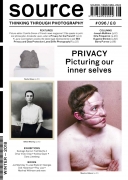Gillian Wearing
Catherine Grant talks to Gillian Wearing
Issue 96 Winter 2018
View Contents ▸
View Portfolio by Gillian Wearing ▸
We look back at the work of Gillian Wearing with an interview by Catherine Grant. The artist talks about the development of her work since 1991.
In Me: Me from 1991, Gillian Wearing is shown with her
eyes downcast, apparently reading a magazine. On the
magazine the same photograph is reproduced, so that
multiple images of Wearing lead the viewer in whilst also
repelling any investment in the photograph as an authentic
representation of self. The work visualises the adage
‘don’t judge a book by its cover’, and gently plays with the
idea that a photographic portrait can reveal inner depths.
With its deadpan humour, this self-portrait is emblematic
of Wearing’s work. Across her career she has explored
the ways in which people present themselves to others,
including herself. She examines the conventions of photography,
video and portraiture, with a keen eye for the
absurd along with a sincere desire to let people speak.
She is a very famous British artist, but unlike some of
her contemporaries who are known for their larger-than-life
characters as well as their artworks, she remains an
enigmatic figure.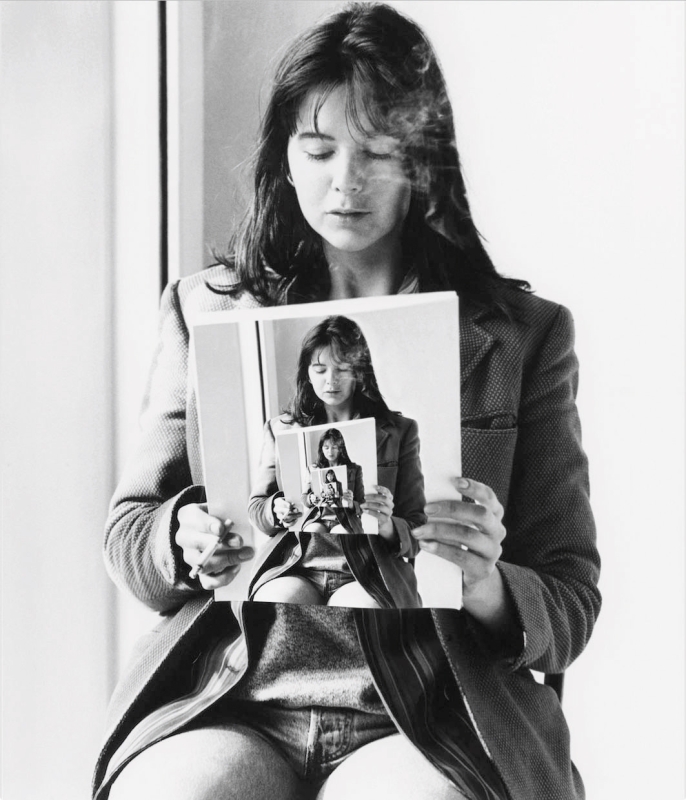 Me: Me (1991)
Me: Me (1991)
In this interview, she reflects on her photographic work beginning with her famous series from 1992-3 that show people holding signs on which they have written their inner thoughts: a still-startling catalogue of the ways in which what people are thinking very rarely matches our impressions of them. This is followed by reflections on the Family Album series, in which she painstakingly reconstructed photographs of family members, performing in each one. This series utilises very realistic masks, a device that has continued in other works, including Spiritual Family, also discussed here, in which she has photographed herself as artists who have influenced and inspired her. Throughout these two series, Wearing is present, but barely visible. The last section of this interview explores her use of the self-portrait, stretching from her very early years as an artist, up to recent works that have visualised what she might look like at age 70. In this last section, Wearing also picks up a question that is present in the Spiritual Family series, namely, what it means to be an artist, as well as the more general question of what it means to represent oneself.
Across the decades of work discussed here, Wearing has consistently attended to this issue’s theme around ‘privacy’ and ‘picturing our inner selves’. She has interrogated the conventions and clichés that surround documentary and portrait photography, film and video, with her recent work on self-portraiture taking on particular resonance in an age of constant self-representation. Long before the digital selfie, Wearing was thinking about what it means to picture the self, and the changing reality of any one person. Indeed, many of her early works, both in photography and video, could be seen as collaborating with people to help them create their own self-portraits. Now, nearly 30 years later, Wearing is a well-known artist with an OBE, a Royal Academy membership, and a string of prestigious international exhibitions. But still she is asking questions that are deceptively, enticingly simple: who do you see here? And how should we picture ourselves?
Signs That Say...
CG: number of your works could be described as the performance of an instruction: as in the famous Signs that say what you want them to say and not Signs that say what someone else wants you to say series (1992-93), or Take Your Top Off (1993). Could you say how you came up with the parameters for these early photographic series?
GW: I had wanted to do something vox pop for a long
while, I had tried filming people on the streets with a
friend’s camcorder but the results yielded something that
was too familiar, like TV. I then tried with the signs series, although I didn’t know if it would work as it relied heavily
on responses from people I approached on the street.
The results of what people wrote were incredible, I could
never have imagined how honest and open everyone
would be to me a stranger with a blank piece of paper
and a pen. That project came at the right moment, before
social media and at a time where there weren’t platforms
where people’s voice could be heard.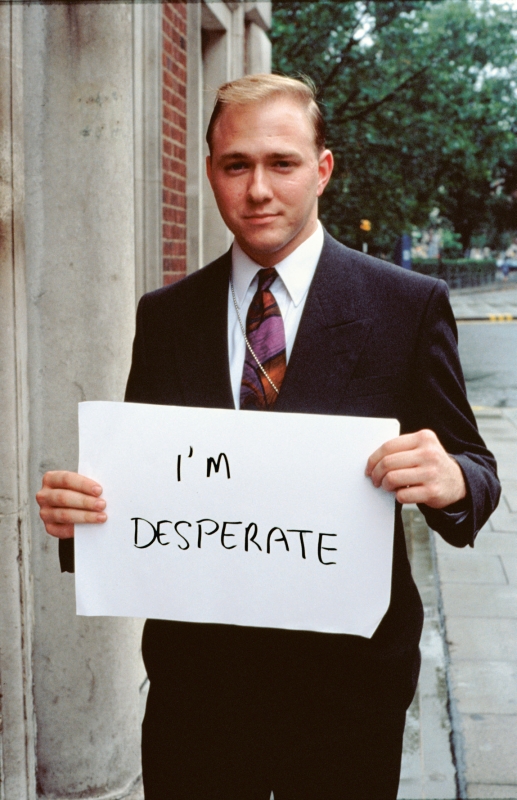 Signs that say what you want them to say and not Signs that say what someone else wants you to say (1992-3)
Signs that say what you want them to say and not Signs that say what someone else wants you to say (1992-3)
The parameters were very open, I approached anyone that passed me on the street. Of course getting someone to stop is the hardest part but when I managed to get someone’s attention most people wanted to participate. The concept really spoke to them, many people said it was a great idea and why hadn’t it been done before, so it really made sense. The only thing is at the time I didn’t know what I would do with the images, I knew they would be good in a publication, so I approached The Face magazine to publish them, which they did over two pages in 1992. I then exhibited them at an artist-run space called City Racing in March 1993.
CG: How has your approach to photography changed over the course of your career? I’m thinking here of an interview from 1999 where you say "...I can’t bear the idea of the technology being something that represents me". (In an interview with Donna De Salvo.)
GW: I think when that question was asked, there were very narrow views of what a photographer or video artist was. Previous generations of artists that worked in these mediums were seen as a separate entity to the other fine arts. So I think I didn’t want to be seen as someone who works in one medium, which I don’t. I am a fine artist, and yes I am interested in technology but I want to make work where the idea is not secondary to the technology.
CG: You have discussed your shyness in approaching people in the photographs featured in the series Signs that say... How did or does this shyness feed into your work?
GW: I like to think it means I don’t overpower a situation. If you’re directing or doing a documentary work you have to listen and take things in. You have to let things breathe. When filming or taking a photograph it shouldn’t be about me but about other people, the work etc.
CG: In a number of works from the mid-late 1990s you focus on duration in video (Sixty Minute Silence (1996); Boytime (1996-8); Girltime (1996-7)). How do these relate to the earlier photographic portraits?
GW: I would add Snapshot (2005) in that list too. I had been looking at daguerreotypes and thinking how I could make a film that dealt with photography and time. That’s where the idea of 60 Minutes Silence comes from: a formal looking portrait of police officers standing and sitting still, but as over time individual characteristics emerge through small face and body gestures it becomes more and more human. A photo of that scene would have rendered the opposite. So what unravels is a portrait over time.
Family Album and Spiritual Family
CG: In the Family Album series you re-staged photographs of your family, often showing them at similar ages. Could you say what the experience was like, and if it changed your relationship to them?
GW: The experience happens over a long period of time, researching which image to use at what age. How it should be made, at times getting costume made. So it is very forensic, I am bringing back to life my family from their pasts in the 1940-80s, and the images that I recreated between 2003-2006 are also in the past now. So I have memories attached to the making and becoming. My personal understanding of my family has changed but not the interactions I have with them.
CG: The Family Album photographs are technically
perfect, very beautiful, enormous renderings of
snapshots and studio shots. Are you interested
in the styles of the photographs that are re-created
in this series?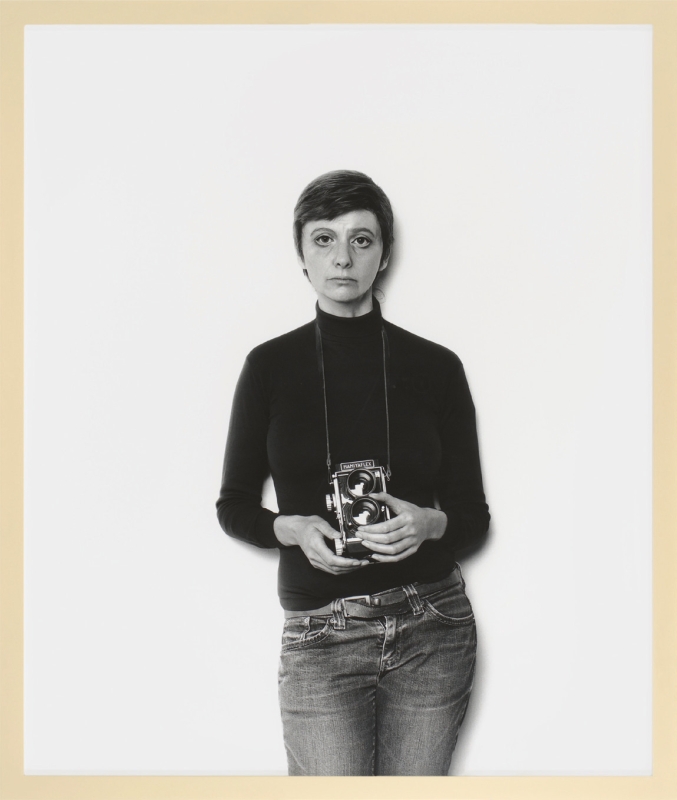 Me as Arbus (2008)
Me as Arbus (2008)
GW: I wanted the series to capture some of the changes in the history of photography. From the formal portraits to the snapshot. Self Portrait As My Brother Richard Wearing (2003) is the most snapshot of all, and is based on one taken by my mother of my brother. He was caught in a private moment with all his personal belongings around him, adding to a sense of who he was/is. The Self Portrait As... series has taken me in a direction where I have dealt with time and, in a way, sculpture, as they are constructions. I am taking something that was a snapshot and spending four months working on it to re-create it.
CG: What inspired you to begin the series of Me As…?
GW: After I had completed my Family Album series I thought of who my spiritual family would be, the artists that have inspired me and guided me in my work. Without those artists I probably wouldn’t have become one myself, they were the culture in my life. I wanted to honour them in return by becoming them. They show who I feel a deep connection with as opposed to who I am connected by through genetics. In quite a few cases I have created the image in the way I wanted the artist to be portrayed, so it is not based on an original.
Portrait Of The Artist As A Young/Old Woman
CG: Your 2000 Self-Portrait seems to mark a change of direction, with the use of the largescale, posed photograph. Could you say something about this image, and why you made it?
GW: Self-portraiture is the first thing I really did as an artist, from painting self-portraits in the 1980’s to taking photos: the Me:Me photo is from 1991 before I did the Signs series. It seems obvious to me to use myself at times, you learn to look at the world through art so of course looking at yourself becomes part of that.
CG: In recent work you have reflected on what you might look like as a 70 year old woman artist, which seems joined to your return to very early images of yourself. What inspired these series?
GW: When Sarah Howgate invited me to do an exhibition
at the National Portrait Gallery (Gillian Wearing and Claude Cahun: Behind the Mask, Another Mask 2017) she
had hoped I would come up with some new self-portraits.
At that time I really didn’t have any plans, but I started
thinking about my future. Future means being older, and
we all change in life physically, mentally. I wanted to
look at how I might look, so I employed forensic and age
progression artists to envisage this. It’s great having input
from other people as they don’t necessarily see what I
was seeing, and of course there is no right or wrong, we are all subjective when it comes to trying portray ourselves
or other people. So I feel the possible me’s of the
future are all quite different. I think this work connects
with the TV programme Seven Up (1964), which has
influenced me throughout my life. This programme was
the first in a series where they followed seven-year-olds,
returning to them every seven years and continuing to this
day. I have set out a possible physical future and when
(and touch wood) I reach that age, I will present me really
at 70 alongside the imagined ones.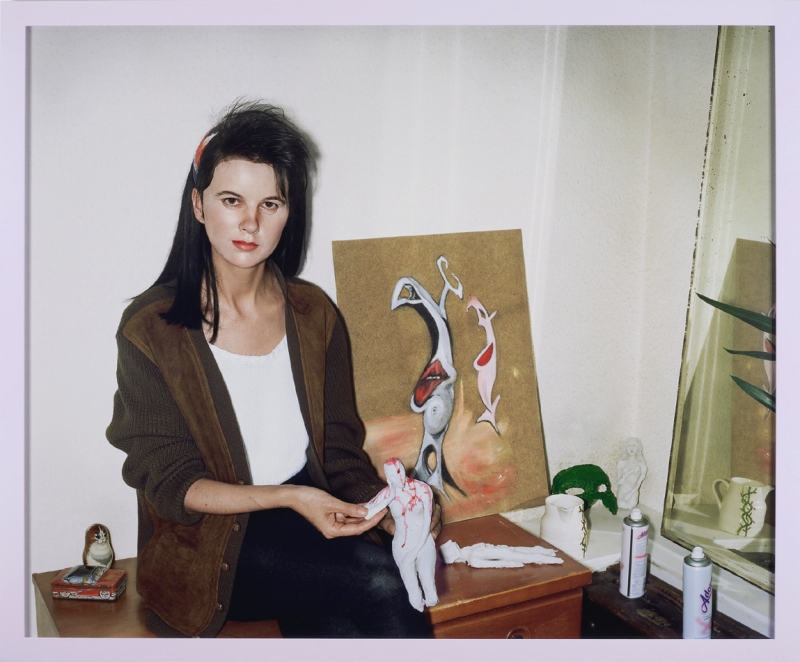 Me as an Artist in 1984 (2014)
Me as an Artist in 1984 (2014)
CG: Recently you exhibited a series of polaroids taken between 1988-2005. What drew you to these Polaroids in 2015? How do they relate to your self-portraits made in the 2000s and 2010s?
GW: The NPG show concentrated on my self-portraits, so Sarah [Howgate] got excited when I spoke of my Polaroids and then we mooted the idea of exhibiting them. What I love about them is that I was not taking them for anyone but me. So even though they had a selfie look they were only for an audience of one. Exhibiting them even I felt I was looking in on someone else, as the communication with myself at that time is past, I wasn’t thinking of how they could be viewed by other people or even how I would see them further down the line. In the exhibition it felt anthropological, like I was studying myself.
CG: In the NPG show the photo Me: Me (1991/2016)
was displayed alongside My Polaroid Years. Could you say a little about this work, which
seems to play with conventions of the artist
self-portrait. It looks like you re-created this
image for the cover of the Observer in 1998?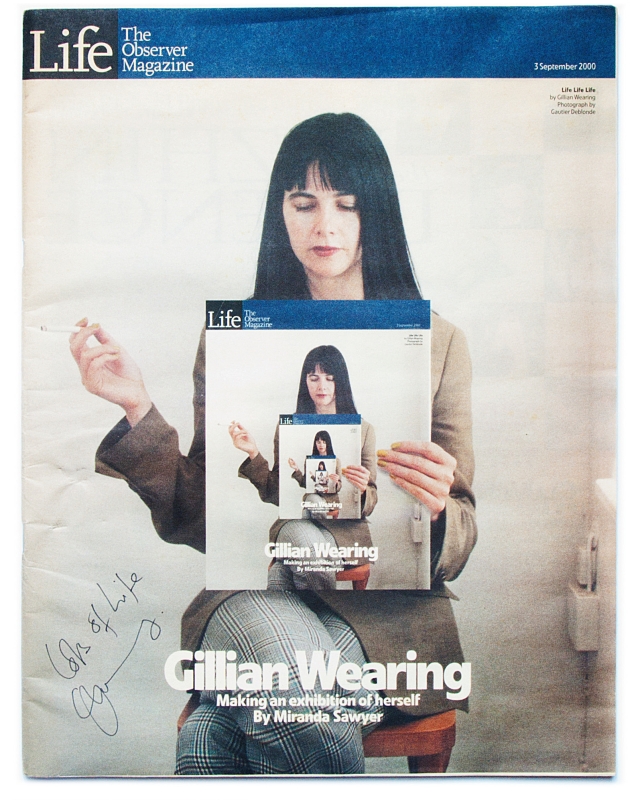
GW: The piece was playing on the positive and negatives of the self, the positives being that it was an empathetic mirroring of the self, of looking into yourself and developing the sense of self identity. Also the many selves we have. The negatives being: self-absorption, self-centred, narcissism and being delighted by your own image.
And yes I recreated the image for the Observer, as I like that the magazine then was called Life, so you had Life, Life, Life repeated on the image as it was repeating. Me Me Me – Life Life Life!
CG: You have described the photograph Me As An Artist in 1984 (2014) as showing "a time before I thought of myself as an artist" (in interview with Sarah Howgate, 2017). What drew you to re-creating it?
GW: It is a pivotal moment in my life just before I decided to become an artist, and the photo looks as if I knew that (I didn’t) or I was one. I am holding a sculpture I have made, there are other works including a painting I created nearby, as well as a half mask from a cast of my face in the corner of the room. It’s an image of my life foretold.
CG: The theme of this issue is ‘Privacy – picturing our inner selves’. It appears that you are a very private person, despite appearing in many of your artworks. Can you say something about this tension between using yourself and not wanting to reveal too much?
GW: It’s not that I don’t want to reveal anything about myself, it’s more about why and when, in what context, what idea.
Other articles by Catherine Grant:
Other articles mentioning Gillian Wearing:
Other articles on photography from the 'Conceptual' category ▸





